My Bose bookshelves have one cap and one fuse.
That is your cross over. Those caps. Did you pull them and check them one by one.
Sony make decent speakers. I have a few.
You do not need fancy equipment to get a basic idea for cross over design.
A simple laptop or smart phone with a freq analyser is better than nothing. Yes I know the mic is not calibrated but at least it will help tell you which driver is mid and which is woofer. Like all old caps even the ones inside speakers have a limited life.
I would have started with fresh caps or pulled what is on the speakers and tested them.
That is your cross over. Those caps. Did you pull them and check them one by one.
Sony make decent speakers. I have a few.
You do not need fancy equipment to get a basic idea for cross over design.
A simple laptop or smart phone with a freq analyser is better than nothing. Yes I know the mic is not calibrated but at least it will help tell you which driver is mid and which is woofer. Like all old caps even the ones inside speakers have a limited life.
I would have started with fresh caps or pulled what is on the speakers and tested them.
These sort of Sony SS-S9 speakers usually have quite nice drivers and virtually no crossover, just a 1.8uF and what must be a solid state fuse here on the tweeter:

Once you give them a proper crossover they can sound very good indeed. I have done this sort of thing.
We are looking at a glorified reflex parallel MTM here I suppose. I would guess those basses are silver painted paper drivers.
To fix them would need some serious effort, which is what I enjoy as a hobbyist.
Like this:



At a guess, I think you could start with one or two coils on the basses, and add a 4 component third order crossover on the tweeter, which is quite Bowers and Wilkins.
I usually try to do a circuit where the only variable is the resistor for tweeter loudness since that is often a matter of taste and a bit of an intuitive guess without measurements.
I would model it in the simple to use Visaton Boxsim with similar drivers to have an idea what is going on. Too much trouble for most people I expect. But interesting and educational. 🙂
Once you give them a proper crossover they can sound very good indeed. I have done this sort of thing.
We are looking at a glorified reflex parallel MTM here I suppose. I would guess those basses are silver painted paper drivers.
To fix them would need some serious effort, which is what I enjoy as a hobbyist.
Like this:
At a guess, I think you could start with one or two coils on the basses, and add a 4 component third order crossover on the tweeter, which is quite Bowers and Wilkins.
I usually try to do a circuit where the only variable is the resistor for tweeter loudness since that is often a matter of taste and a bit of an intuitive guess without measurements.
I would model it in the simple to use Visaton Boxsim with similar drivers to have an idea what is going on. Too much trouble for most people I expect. But interesting and educational. 🙂
Last edited:
Those two parallel drivers work without a crossover for most of the range. One is like extended range, and the other probably works better low frequencies. The tweeter is actually something like a super tweeter.The speakers are 8 ohm, mid is closer to 10 ohms, they are all connected in parallel and there are 2 caps on the in put in series with the po +
Check the correctness of those tweeters with the instrument. Replace the electrolytic cap 1.8uF with some block capacitor of the same value, cap voltage 100V or more. If you can't find 1.8uF caps, buy 1.5uF+0.33uF (or 1uF+0.82uF) and connect it in parallel. Instead of that brown fuse (or whatever it is), put a wire jumper.
Last edited:
For example one SEAS KIT, 3.3uF +10ohm is all there is from the crossover.
https://www.seas.no/index.php?optio...eas-a26-kit&catid=66:seas-diy-kits&Itemid=250
https://www.seas.no/index.php?optio...eas-a26-kit&catid=66:seas-diy-kits&Itemid=250
Is this the crossover circuit that you used for your Sony SS-S9 speakers?
I know only what you have told me about your Sony SS-S9 speakers. I don't even know if they are 4 or 6 inch basses.
If I did, I would know what to do with them to improve.
Bottom line is you own some cheap garbage. But with a will, things could be improved. It's up to you.
I will help if I can. I have a low failure rate.
Best Regards from Steve in Portsmouth UK.
If I did, I would know what to do with them to improve.
Bottom line is you own some cheap garbage. But with a will, things could be improved. It's up to you.
I will help if I can. I have a low failure rate.
Best Regards from Steve in Portsmouth UK.
Thanks Steve.
This is all the information i have. I wouldn't say they sound bad, just not very good, a little muddy for my liking but having said that, I need to remind myself that I am 66 year old and suffer from industrial hearing impairment. Cheap garbage? That hurts, but true lol, I only paid $20 for them. I think that part of the problem may be the enclosures, Plastic front, No baffles, No sound deadening, very little bracing.
See pics.
This is all the information i have. I wouldn't say they sound bad, just not very good, a little muddy for my liking but having said that, I need to remind myself that I am 66 year old and suffer from industrial hearing impairment. Cheap garbage? That hurts, but true lol, I only paid $20 for them. I think that part of the problem may be the enclosures, Plastic front, No baffles, No sound deadening, very little bracing.
See pics.
Attachments
-
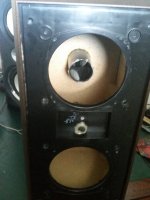 20231008_113403.jpg322.1 KB · Views: 181
20231008_113403.jpg322.1 KB · Views: 181 -
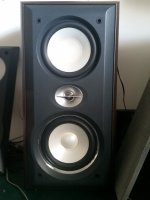 20231008_112434.jpg226.3 KB · Views: 143
20231008_112434.jpg226.3 KB · Views: 143 -
 20231008_112359.jpg258 KB · Views: 183
20231008_112359.jpg258 KB · Views: 183 -
 20231008_112245.jpg208.1 KB · Views: 151
20231008_112245.jpg208.1 KB · Views: 151 -
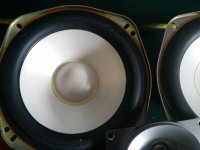 20231008_112238.jpg216.1 KB · Views: 132
20231008_112238.jpg216.1 KB · Views: 132 -
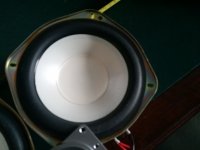 20231008_112216.jpg171.7 KB · Views: 155
20231008_112216.jpg171.7 KB · Views: 155 -
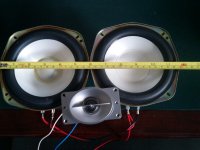 20231008_112203.jpg241.2 KB · Views: 176
20231008_112203.jpg241.2 KB · Views: 176 -
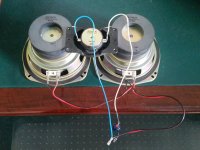 20231008_111943.jpg395.3 KB · Views: 320
20231008_111943.jpg395.3 KB · Views: 320
Hi guys . I just bought sony s7av with ss-s9 speakers . It costs too much in my country and im disappointed. I have another pair of dp800d speakers with same drivers but different design . Im a newbie but I think these are 2.5 way and thats the problem. I have a mini Panasonic sb-ch7 4 terminal and it sounds amazing comparing to s9 and its cost half a price for me .i found some MTM design and crossover but i dont know exactly what are s9 driver's . I post the link hope it will help find a solution for these speakers . Sorry about my English
http://www.hificircuit.com/communit...mbre-matched-family-of-hi-fi-ht-speakers.319/ take a look at mtm and its crossover . Please post updates if you have got improves🙏🤝
http://www.hificircuit.com/communit...mbre-matched-family-of-hi-fi-ht-speakers.319/ take a look at mtm and its crossover . Please post updates if you have got improves🙏🤝
From what I am seeing, and you have no electrical measurements, you could do worse than this:
http://www.troelsgravesen.dk/VifaPL14WJ-R2604.htm


You may not need R1051 and R1061. R1011 is where the level adjustment is. Mr. Troels has a low failure rate too. One of my loudspeaker heroes. 🙂
http://www.troelsgravesen.dk/VifaPL14WJ-R2604.htm
You may not need R1051 and R1061. R1011 is where the level adjustment is. Mr. Troels has a low failure rate too. One of my loudspeaker heroes. 🙂
That Troels crossover (like all the others he's built) is carefully designed based on the measurements of those Vifa drivers in a box of certain dimensions, a lot of simulations and corrections. There's no way it would fit completely different drivers in another box. It wouldn't even quite match those Vifa drivers in a significantly different box. I don't recommend these improvisations, it's a waste of money and time without any prospect of success.
Feedback
Feedback
@NIXIE62, you right up to a certain point. That Vifa project is really for a 4 ohm tweeter.
What do you think about this one with a tweeter attenuator of two resistors added?

https://www.visaton.de/en/products/accessories/crossovers/hw-270-ng-8-ohm
What do you think about this one with a tweeter attenuator of two resistors added?
https://www.visaton.de/en/products/accessories/crossovers/hw-270-ng-8-ohm
Hi guys . Can you help me for design sony s9 version of this ? Im Newbie and don't know where i should start . If its possible to do measurements please guide me . Is there any simple way to make this speaker from 2.5 way to 2 or 3 way ? Like replacing one of woofers or add or remove a capacitor ?
If i want to test and try that cross over can i use normal capacitor? I don't have access to crossover grade now 🙏
If i want to test and try that cross over can i use normal capacitor? I don't have access to crossover grade now 🙏
The problem is not only that the tweeter is 4ohm, but because the crossover is made for different drivers and boxes.What do you think about this one
That second crossover is generic, I also don't expect the result to be anything good.
I already said what to do, replace the 1.8uF capacitors and bridge those fuses to begin with.
Thank you kindly. I have measured the caps in both speakers and they both measure at 1.77uf and the L12 334 measures at .334uf on a 2uf scale, so they are well within spec. should I just bridge the L12 334?replace the 1.8uF capacitors and bridge those fuses
So it's a parallel connection of 1.8uF and 33nF (in total approximately 2.2uF) and everything is correct. It doesn't have any Fuse. Now you should check the tweeters, measure their DC resistance. That electrolyte you measured may have an increased ESR due to age, that's why I said to definitely replace it. Can one 2.2uF PP instead of both of those factory ones.Thank you kindly. I have measured the caps in both speakers and they both measure at 1.77uf and the L12 334 measures at .334uf on a 2uf scale, so they are well within spec. should I just bridge the L12 334?
2.2uF with 8 ohm tweeter gives a cut-off frequency of 9Khz -3dB, slope is 6db/oct. That is quite high. For a test I would add 1uF in parallel with those capacitors. This will raise the slightly high spectrum in the zone below 9kHz and give you a more open sound. The new tweeter cut-off frequency is in that case is 6.2kHz -3dB. Also a PP cap will give you a brighter sound than a bipolar electrolytic.
All of this only makes sense if the tweeters are fully functional.
Last edited:
You can also try some measurement with a mobile phone. There are apps on Google Play (spectrum analyzer or something). You can find an online white noise generator on your PC/laptop, play it not very loud to the audio system and measure it with your mobile phone at a distance of 1m from the speaker in tweeter axis. You measure one channel at a time.
There are also USB measurement microphones, they are not expensive.
https://www.amazon.com/miniDSP-UMIK-1-Measurement-Calibrated-Microphone/dp/B00N4Q25R8
https://www.amazon.com/Dayton-Audio-UMM-6-Measurement-Microphone/dp/B00ADR2E68
There are also USB measurement microphones, they are not expensive.
https://www.amazon.com/miniDSP-UMIK-1-Measurement-Calibrated-Microphone/dp/B00N4Q25R8
https://www.amazon.com/Dayton-Audio-UMM-6-Measurement-Microphone/dp/B00ADR2E68
Last edited:
I wouldn't bother with this.But first do the following, replace that bipolar electrolytic cap in the Sony, it is responsible for reproducing part of the mid and high frequencies. Bypass it with a 1uF polypropylene cap.
I'm not aware of any AB test proving the bypass cap theory.
I spent a couple of hours this afternoon simulating something close to this Sony SS-S9 speaker in good old Visaton Boxsim 1.2 which I like and have uploaded here:
https://www.diyaudio.com/community/...-from-visaton-free.267787/page-2#post-7126272
The single 2.2uF capacitor solution looked dreadful in every aspect.
Interestingly, Visaton's off the shelf HW 2/70 NG 8 ohm did pretty well when I adjusted two resistors:

I have seen worse than this and Loudspeaker genius Joachim Gerhard always said +/- 2dB is good enough.

And the phase bit that nobody except me is ever very interested in:

In fact I think this Visaton crossover is better for a 4 ohm bass load. But here that is close to the case.
3.5 kHz bass filters tend to either 1mH/10uF, 1.5mH/6.8uF or 2mH/4.7uF. Except with high inductance basses which can use impedance correction.
Delving into my box of parts, for some intuitive reasons, I would try 1.5mH/6.8uF first with this Sony. The basses seem to be an unusual 10 ohms DCR.
Well, I'll stop there.
https://www.diyaudio.com/community/...-from-visaton-free.267787/page-2#post-7126272
The single 2.2uF capacitor solution looked dreadful in every aspect.
Interestingly, Visaton's off the shelf HW 2/70 NG 8 ohm did pretty well when I adjusted two resistors:
I have seen worse than this and Loudspeaker genius Joachim Gerhard always said +/- 2dB is good enough.
And the phase bit that nobody except me is ever very interested in:
In fact I think this Visaton crossover is better for a 4 ohm bass load. But here that is close to the case.
3.5 kHz bass filters tend to either 1mH/10uF, 1.5mH/6.8uF or 2mH/4.7uF. Except with high inductance basses which can use impedance correction.
Delving into my box of parts, for some intuitive reasons, I would try 1.5mH/6.8uF first with this Sony. The basses seem to be an unusual 10 ohms DCR.
Well, I'll stop there.
Last edited:
- Home
- Loudspeakers
- Multi-Way
- Advice on Sony 3 way speakers without crossover